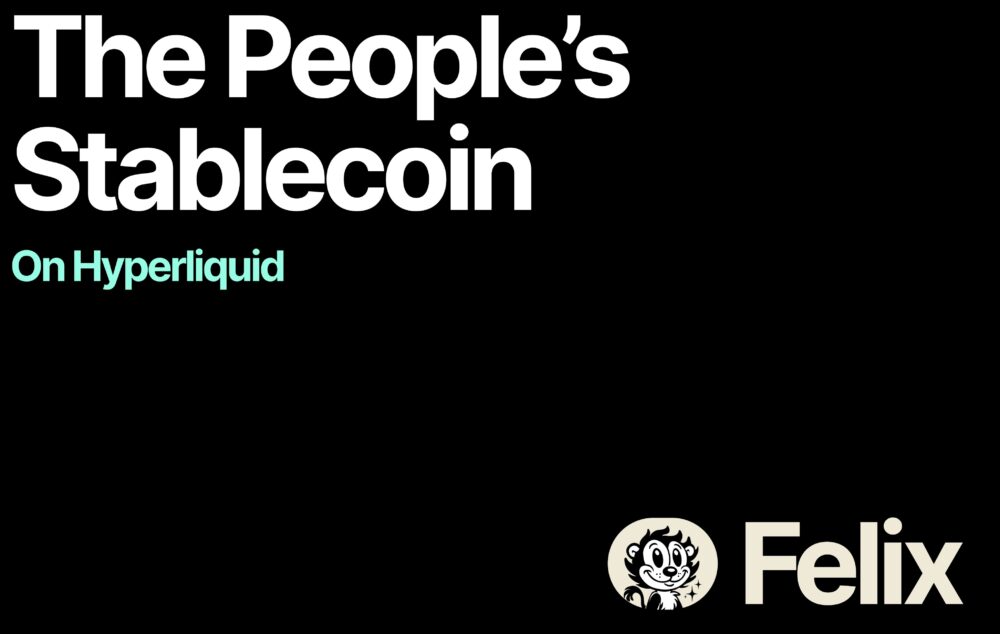What is Felix—and why it matters
Felix is a Hyperliquid‑native stablecoin and lending protocol, built on the HyperEVM layer. It lets users deposit blue‑chip collateral like HYPE, ETH, or BTC, and borrow feUSD, a soft‑pegged stablecoin.
Felix ranks as the second-largest DeFi protocol on Hyperliquid, with TVL ranging between $340–$400 million
Growth, TVL, and user adoption
Since its mainnet launch in April 2025, Felix has exploded in growth. In just a few months, its outstanding loans surpassed $100 million, with $61 M from CDP borrowing and $43 M via vanilla markets.
Meanwhile the entire HyperEVM ecosystem (Hyperliquid L1) has scaled rapidly, reaching $1.7–$2 billion TVL by mid‑2025, up 337 % since early in the year
Felix consistently holds about 17–18 % of all TVL on HyperEVM, trailing only HyperLend as the biggest lending protocol. It has grown about 100 % since mid‑April. That growth shows both user traction and capital efficiency.
How to Make Money with Felix
Felix isn’t just a cool DeFi protocol. It’s also a place where you can put your crypto to work. Whether you’re more into stable income or strategic borrowing, there are multiple ways to earn. Here’s how:
1. Stability Pool: Earn from liquidations

This is one of the easiest and most passive ways to earn with Felix.
When people borrow feUSD on Felix using crypto like ETH or HYPE as collateral, there’s a chance that their loans become under-collateralized. When that happens, Felix automatically liquidates those risky positions. The Stability Pool steps in and buys that discounted collateral, at a profit.
If you stake feUSD in the Stability Pool, you help fund these liquidations. In return, you get rewarded with:
- ETH or HYPE at a discount (from liquidated positions)
- Felix points (which could turn into future airdrops)
- Native yields, depending on how active liquidations are
Think of it as a savings account that earns when the market gets volatile.
Tip: Stake feUSD only if you don’t need it immediately, as you’re helping backstop the system.
2. Borrowing: Get liquidity without selling

Most people borrow because they want to get cash (feUSD) without having to sell their valuable assets like ETH, BTC, or HYPE. It’s like taking a loan from yourself.
Here’s how it works:
- Deposit your crypto as collateral.
- Mint and borrow feUSD.
- Use that feUSD in the Stability Pool, farm on other protocols, or even trade.
Why this can be profitable:
- You keep exposure to your crypto while accessing capital.
- Reinvest the feUSD into other earning strategies (e.g., staking or liquidity pools).
- Earn Felix points, which could bring a future token airdrop.
Tip: Always monitor your collateral ratio. If it drops too low, you risk liquidation.
3. Lending: Earn passive yield

If borrowing feels too active for you, lending is a calmer path. Felix has “vanilla” money markets where you can lend out stablecoins like feUSD, USDT, or USDC to other users.
In return, you earn:
- Lending interest, paid by the borrowers
- Felix points, helping you qualify for any future rewards
- Exposure to low-risk DeFi earnings while staying in stablecoins
Tip: Lending stablecoins is generally less risky than volatile assets, and a great entry for new users.
Felix gives you the flexibility to earn in your own style, whether you’re chill and just want passive income, or you’re a degen exploring leverage and loops. It also give airdrops every 2 or 3 weeks
Felix offers a smooth, user-friendly way to borrow stablecoins, provide liquidity, and explore DeFi on a rapidly growing chain without trusting centralized platforms. As Hyperliquid expands, so too does Felix’s opportunity to stay central, supportive, and rewarding.
If there’s something you want me to cover next, just let me know. You can follow me here on my website and my Medium to get my latest updates as soon as they drop! You can also contact me through X @AskaraJr and Linkedin


